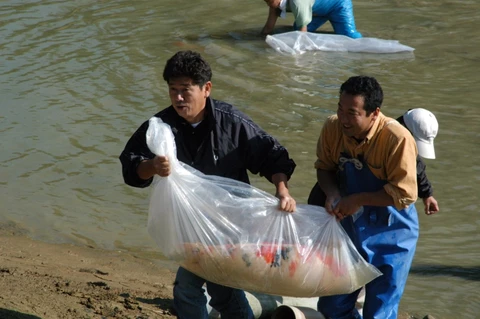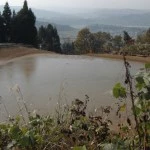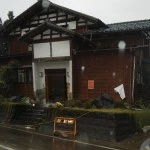When I first started visiting the Niigata mountains in 1992, it always felt like a magic place.
It was a very personal industry, buying Koi seemed like a secondary purpose of actually being there. 
Try and imagine small villages and pretty much all of them had something to do with Nishikigoi. Breeding or just dealing in Koi. The Auctions played a huge part of the industry ‘Back in the day’ I think Mya-Koya Auction is up there with supplying many All Japan Koi Champions over the decades. The Auctions closed when the KHV scares/and cases came out in Japan. Export restrictions were threatened and everyone had to start taking the Koi very seriously. No more popping to another breeder down the road and borrowing a few parents to spawn with, no more wheeling and dealing which did close many part time breeders down, they now had nowhere to sell their Koi. Some actually turned from part time to full time and are still selling Koi today, however the main breeders you see in Niigata today are still going.
I remember going to Auctions quite a lot in the late 90’s and 00’s. They were a very easy way to source Koi, if you had somewhere to hold the Koi later anyway, which at the time we did.
I think if memory serves me right there were 2 or 3 major Auctions a week, some were for cheap general grade Koi and I believe (again from memory) there was even a monthly 1Million Yen Auction where the bids started at over £5000 at the time, so not just general grade Koi.
Of course, there were still the main Koi breeders who were breeding and selling Koi. They are pretty much all still around today… Only one difference. The Sons have taken over the family business.
When I started going, as I said, Koi was just a thing to do after we had had tea and lunch, or just randomly being invited in for Strawberry’s or Apples. Then we would go and see what Koi they had and buy them. It was not as ‘Commercial’ as it is now.
I believe the major shift in Japan happened after the big Earthquake of 2004. This changed the scenery of the mountains. It also changed the way business was done in the mountains. It took many years for the mountains to take shape again and look similar to before the Earthquake. Probably about 5/6 years.



During this time, many of the breeders were entrusting their Son’s with more and more. Some were doing the actual breeding, and doing more of the culling, to a later stage anyway. I guess at this time the Internet had started to actually work for business’s and the Young breeders saw how it worked, they started looking into branding, online sales and everything else that comes with it. It did not take long either.
I remember when Dainichi had their logo done, it was on a couple of bowls around the main facility… now they have around 6 places in Niigata and each one is plastered in the Logo, you only have to drive around the mountains and you will see a small white truck with the Dainichi sticker on it. Many other breeders saw this and have gone the exact same way. It’s been quite interesting seeing the changes between each trip.
There are still some breeders who are ‘old school’ but these are the smaller breeders, sometimes these are the breeders who concentrate on quality, not so much quantity.
The larger Niigata breeders now are commercial business. You go in, you look, you ask a price and you buy. You may have to wait your turn, you may have to make an appointment. Pads come out with each company having one, it is all logged. We log them on our Phones there and then and we leave.
Some we stay and have tea or something but now they are so busy they have no time for that.
Companies like Marusei are un-real in their work ethic.
They are probably the largest producing breeder in Niigata, maybe in all Japan. They are shipping 365 days a year. In the Harvest season, they must get around 2/3 hours of sleep a night. They get up at 3am and Harvest Koi until it goes dark again. Incredible amounts of Koi and such a small staff considering they are shipping up to 1000 boxes a week.
They all work VERY hard, it’s something you notice a lot. Even after the Harvests they are preparing the mud ponds for the following season, and getting them ready before the snow falls.
My main point being is that the Mystic has pretty much disappeared in the Mountains. We kind of know what to expect these days, hidden surprises are very few and far between…they can still happen but the Younger generation of Koi breeders run slick operations, they are fully commercial and run very well, all Koi are accounted for and graded. The days of coffee and Strawberries are pretty much gone…I still know a couple who offer great tea though!
The main reason I wanted to write this was something completely different but it kind of ties in with the Mystic.
In Japan, last Autumn we were sat at a breeder’s house actually having lunch after a Harvest. The subject got onto parasites in Koi… as it always does at some point when you get a group of crazy Koi Keepers together.
One of the guys asked a question I have heard MANY times and I knew the answer instantly.
“Do you have a microscope?”
Luckily for the breeder, his young son was there who understood the English word Microscope. The look on his face was brilliant, one of confusion and bemusement.
After a few seconds, he simply said “No, we don’t need” he explained what the guys were talking about to his Father who said, “They have one of those at the Village office” Yes, it was 2017.
Something serious Koi Keepers in the UK now take for granted is pretty much un-heard of in the place where they produce the best Koi!
The Japanese way of caring for Koi is the total opposite of what we know, I often scratch my head at some of the things they do knowing full well, if I tried it, I would have a lot of sick Koi on my hands.
The treatment regimes they use always baffles me. I have seen Potassium dips so strong they stain the Koi brown for days. I have seen them use house hold bleach to clean systems, rinse and full in an hour and add Koi.
One of the biggest ‘Mountain Myths’ is that they use the natural springs from the mountains. This is total rubbish these days. They all use tap water, or as they call it ‘City Water’ and they pay for it like we all do. I am talking about their Koi facilities. Obviously, the mud ponds still get most of the water from the snow but some breeders have tap water on site at their mud pond locations. However, the main Koi houses are all on Tap.
The heat comes from Oil which gets delivered by tankers. You see the small oil tankers around the mountains all the time.
The fry after they have had their first 4 months in the mud ponds go into a constant temperature. I don’t know each breeder’s exact temperatures they keep their tosai at, but the ones I do know keep them between 21C and 23C. Most saying 23C is the optimum temperature for growth and health.
This will make a total growth of their very best Tosai from 2mm to sizes of up to 50cm plus in the space 11 months. Quite remarkable how they do it while the Koi look great too.
I have probably written this a dozen times but it still impresses me.
A smallish breeder will produce around 5million eggs per year, let’s say Kohaku, Sanke and Showa.
So, in May, they have 5million eggs… 8 months later they have 2500 Koi left. 11 Months they will make the final selection of what will be grown on, they will be left with 300…
This brings me onto my personal favorite myth when it comes to Koi.
“The Breeder keeps his best Koi and will not sell them”
I have never seen this really. Some breeders will simply say “Tategoi, not for sale”
I know for a fact they are for sale, I have bought ‘Tategoi, not for sale’ many times in the past… for customers who have ready access to these Koi. Customers with deep pockets.
A Breeder will sell what he thinks he can sell, it’s very rare someone will risk spending large amounts of money on Koi that are under a year old. It does happen though.
A breeder only needs 4 months to take a 25cm Koi up to 50cm. The breeder doesn’t know if its 100% female, he doesn’t know if the pattern will come out, doesn’t know if the colour will be good… It might die in the mud pond! So, if you did buy, let’s say his best Tosai, in his opinion, that breeder will probably want close to what he thinks it will be like at Nisai. In my opinion, its best to wait. I have told many of my clients to wait, but some of you Koi keepers are a little bit… nuts and don’t like to wait! They are available though, just need to pay the right money. Like in all cases, everything is for sale in Japan.
I feel lucky I have seen the before and after Japan. I have seen it in so many different styles. I hope to see it change even more.
I still love going there and seeing the people I have known for over a quarter of a decade and hope to see them for another 25 years. I have always embraced the changes and moved with them. The issue now is that Japan changes at a very fast rate. With technology expanding faster and faster, I can only imagine what Koi buying will be like in 10 years’ time.
I remember opening Koi boxes at Heathrow airport with polaroid pictures in the bottom with the prices on the back. A Sony camera with a floppy disc inserted…
Now we send instant videos from our phones, live video chat from Japan… The mind boggles at the future.
